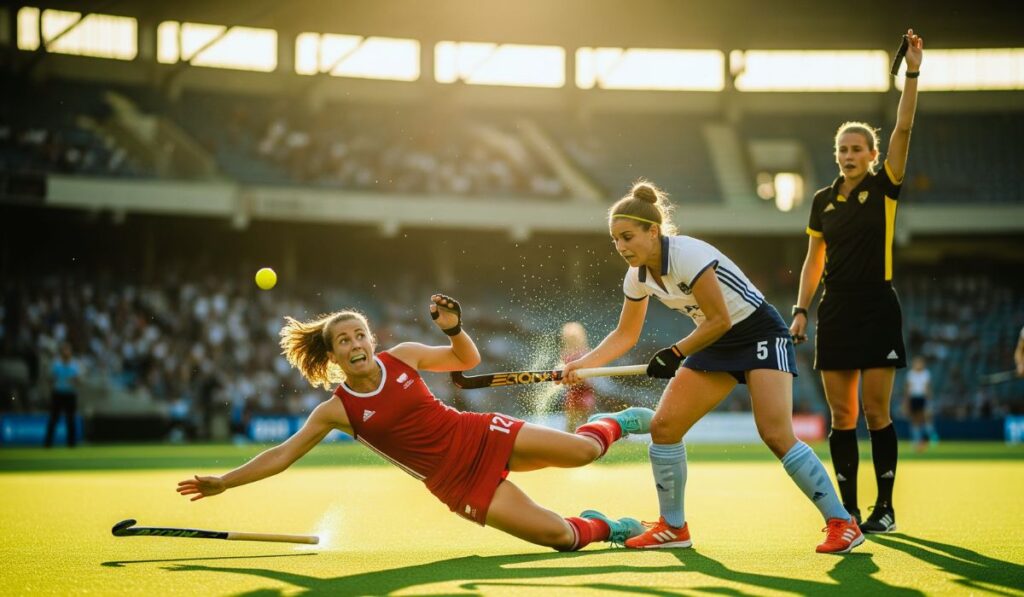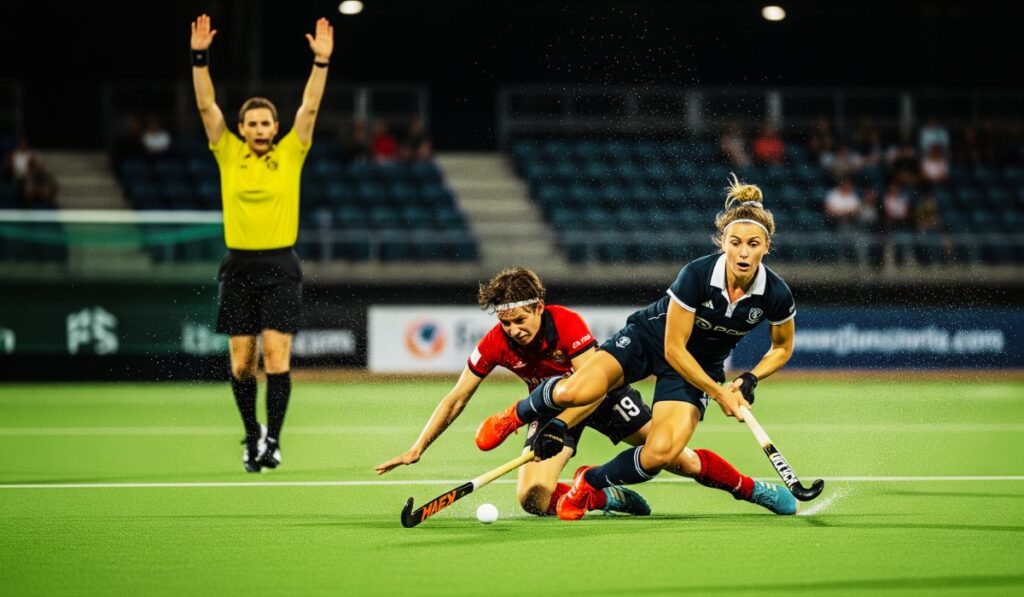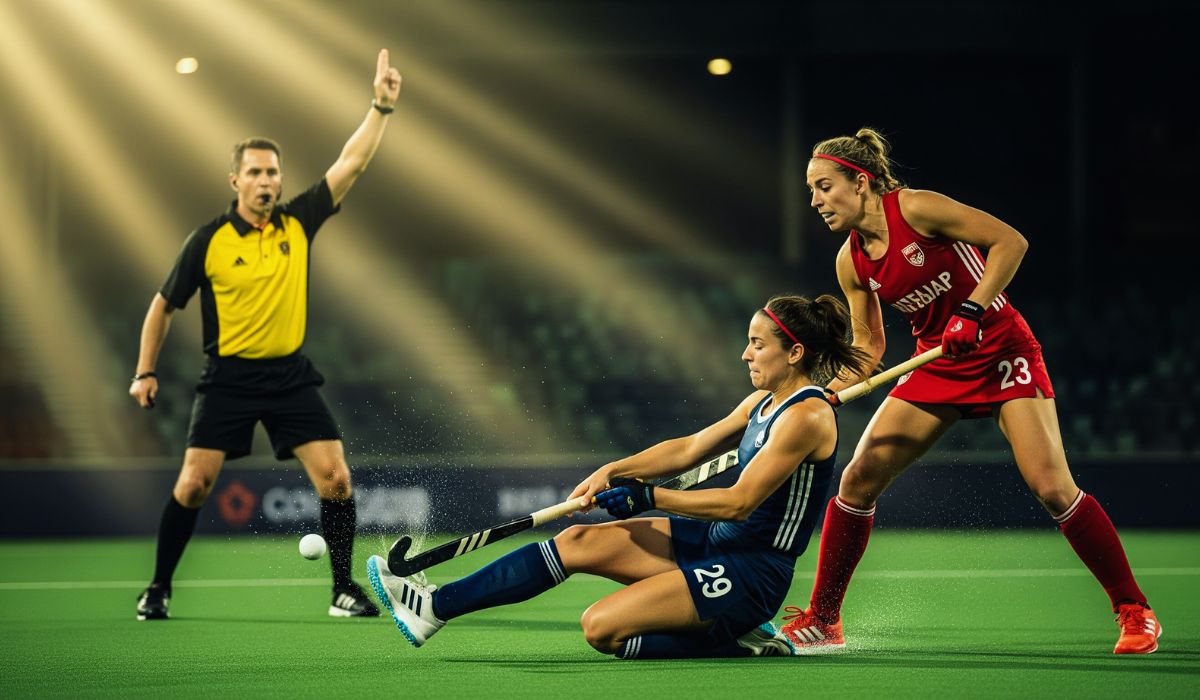In a sport as fast, fiery, and physical as hockey, the line between fierce competition and illegal play is often razor thin. Whether it’s a subtle push or a blatant hit, fouls in hockey can change the rhythm of a match—or ruin it completely. Knowing the rules isn’t just for referees. Every player, coach, and fan should understand the fouls that can make or break a team’s chances. the consequences of each, and how smart players learn to walk that fine line between aggression and illegality. Whether you’re a beginner or a seasoned player, understanding these details could give you the edge you’re looking for—or save you from a devastating mistake.
Obstruction: The Invisible Barrier That Can Cost You Big
Obstruction is one of the most misunderstood fouls in field hockey. It happens when a player uses their body or stick to shield the ball from an opponent unfairly. While shielding is allowed to some extent in other sports, in hockey, it’s illegal if it denies an opponent the opportunity to play the ball. This can seem subtle on the field, but to a trained umpire, it’s clear—and costly. Obstruction often leads to a free hit or, worse, a penalty corner, placing your team in immediate danger.
Stick Interference: When Control Turns into Chaos
Using your stick improperly—like raising it too high near an opponent or hooking someone else’s stick—is not only dangerous but also against the rules. Stick interference disrupts the game’s natural flow and can escalate tensions quickly. Players are trained to keep their sticks below shoulder height, especially during tackles. Violating this rule can result in a fouls of hockey or even a green or yellow card, depending on severity.
Body Contact: Hockey Isn’t Rugby
Hockey is not a full-contact sport. Unlike ice hockey, field hockey penalizes most forms of body contact. Charging, pushing, tripping, or using any physical force to gain advantage is considered a fouls of hockey. The goal is to promote fair play and reduce injuries. Committing such fouls repeatedly may lead to suspensions or even being red-carded, which removes a player from the game entirely.
Back Sticks: The Common Beginner’s Error
A common fouls of hockey among newer players is using the rounded side of the stick. In field hockey, only the flat side of the stick is legal for hitting, passing, or controlling the ball. The moment a player uses the back of the stick—whether intentional or not—it results in a foul. While it may seem like a minor infraction, frequent back stick fouls can interrupt your team’s momentum and hand possession to the opponent.

Foot Fouls: Your Legs Can’t Play the Ball
Field hockey is strictly played with the stick. If the ball hits a player’s foot or leg and gives them or their team an advantage, it’s ruled a fouls of hockey. While unintentional contact might be forgiven by the referee in non-crucial moments, purposeful or repeated foot fouls often lead to penalties. Smart defenders learn to angle their bodies and control their feet to avoid such errors.
Dangerous Play: Aggression That Crosses the Line
Speed and intensity make fouls of hockey thrilling, but they also invite risk. Dangerous play involves any action that threatens the safety of another player—this includes wild swings, high balls into crowds, or aggressive tackles. It’s one of the most serious fouls and can lead to penalty corners, cards, or even disqualification. Referees are especially watchful for dangerous play in youth leagues where safety is paramount.
High Ball Misuse: Not Every Aerial is Allowed
Aerial passes can be exciting and strategic, but they’re only legal if executed properly. A high ball must be controlled safely and should not land among players unless there is a clear receiver. If it poses a risk, the umpire will call a fouls of hockey immediately. Misjudging an aerial pass can result in a penalty and swing the game in the opponent’s favor.
Third Party Obstruction: The Silent Saboteur
This lesser-known but serious fouls of hockey occurs when a teammate interferes between an opponent and the player with the ball. It often goes unnoticed by the casual observer, but umpires are trained to spot it. Third party obstruction not only disrupts fair play but also can give an unfair advantage, and is penalized accordingly. Players must maintain spacing and avoid clustering to steer clear of this error.
Five-Meter Rule Violation: Rushing Too Soon
After a free hit is awarded, opposing players must be at least five meters away. Jumping in too soon disrupts the restart and counts as a fouls of hockey. It’s not just a technicality—violating the five-meter rule can lead to upgraded penalties like a penalty corner, especially in critical scoring areas. Discipline and patience are essential here, even in the heat of the moment
Rebound Interference: When Eagerness Becomes Illegal
After the goalkeeper saves a shot, the area becomes highly contested. However, players must not interfere unfairly, especially by blocking the keeper’s movement or obstructing their view. Overly aggressive actions during rebounds can lead to fouls and even disciplinary cards. Skilled attackers know how to apply pressure legally, while smart defenders and goalkeepers protect themselves within the rulebook.
Delay of Game: Killing the Clock Can Cost You
Wasting time—whether by walking slowly to a restart or deliberately fumbling the ball—is a serious fouls of hockey. Hockey is a fast-paced sport, and intentional delay can provoke penalties and even cards. Referees are strict on this, especially during close matches or in the final minutes. Coaches often drill players on how to stay active and alert to avoid giving the impression of delay.
Improper Substitution: Timing is Everything
Substitutions are allowed freely in hockey, but only under strict conditions. If a player enters the field too early or leaves improperly, it can result in a team fouls of hockey. This can severely disrupt your side’s strategy and rhythm, especially if done during a critical moment. Teams should rehearse clean substitution procedures to avoid handing the opponent a free hit or corner.
Breaking on Penalty Corners: Anticipation Gone Wrong
Defenders often try to anticipate the striker’s move during a penalty corner. However, if a defender runs out too early—before the ball is injected—it results in another penalty corner or may reduce the number of defenders allowed inside the goal. It’s a high-stakes moment, and breaking early not only leads to disciplinary actions but also weakens the defense for a powerful scoring chance.
Intimidation: Playing Mind Games the Wrong Way
While mental toughness is key in hockey, direct intimidation—like shouting, gesturing, or aggressive posturing—is not tolerated. It creates a hostile environment and undermines sportsmanship. Umpires are quick to penalize players who cross this line. Respecting opponents while staying competitive is a delicate balance but an essential part of the game.
Repeated Infringements: A Pattern That Gets You Carded
Even minor fouls of hockey become major if repeated too often. Umpires take note of patterns, and a player consistently committing fouls may be carded even if the individual actions seem small. This can escalate from a green card (temporary suspension) to a yellow or red. Consistency and discipline are crucial, especially when the game is on the line.
Why Understanding Fouls Can Make or Break Your Hockey Career
Many young players focus on speed and skills but forget the mental game—and fouls of hockey are at the heart of that. A minor mistake in judgment can lead to a foul, which may cost your team a goal or even the match. Coaches watch closely, and repeated fouls of hockey can cost you your spot in the lineup. On the other hand, a disciplined player who knows how to play aggressively without crossing the line becomes invaluable.
Understanding the difference between tactical aggression and careless fouling is what separates great players from good ones. fouls of hockey don’t just impact your personal record—they disrupt the team’s rhythm and morale.
What Is a Foul in Hockey?
At its core, a foul in hockey is any action that goes against the rules and disrupts fair play. Hockey is a fast-paced, high-contact sport, but that doesn’t mean anything goes. The rules are strict, and fouls are enforced to ensure safety, fairness, and skill-based competition.
fouls of hockey can be intentional or unintentional. But make no mistake—intent doesn’t excuse the outcome. Players are expected to control their bodies, sticks, and decisions at all times. A simple slip-up can result in penalties, free hits for the opposition, or even cards for the player.
The Emotional Weight of a Foul on the Field
There’s a moment of silence after a whistle—when a player knows they’ve committed a fouls of hockey. The adrenaline drops. Teammates sigh. Coaches raise their voices. The crowd reacts. This emotional spiral doesn’t just affect one person—it touches the entire team dynamic.
In elite-level hockey, a single fouls of hockey can shift momentum, hand possession to the opposing side, or allow a penalty corner. That’s why top players train not just for physical skill but emotional control. Learning to recover mentally after a foul is just as important as preventing one.
Types of Fouls in Hockey: From Common to Game-Changing
Fouls in hockey are categorized into several types, each with its own implications. Here are the major categories:
Stick Fouls
These occur when a player misuses their stick in a way that endangers or obstructs another player. Common examples include:
- Hitting an opponent’s stick aggressively
- Tripping a player using the stick
- Lifting the stick dangerously
Stick fouls of hockey are among the most frequently penalized and can often result in penalty corners or cards.
Obstruction
Hockey requires players to move freely. If a player deliberately blocks another from reaching the ball, even without touching them, it’s obstruction. It doesn’t matter if contact happens—intentional interference is still a foul.
Body Contact Fouls
Unlike some sports, hockey restricts physical contact. Pushing, charging, or using the body to block opponents is considered a foul. These actions are closely watched by referees and usually penalized harshly.
Dangerous Play
Any play that puts another player at risk is considered dangerous—even if unintentional. High stick lifts, hard hits near the head, and reckless swinging are common examples.
Backsticks
Using the rounded side of the stick to play the ball is illegal. While this may seem harmless, it violates the sport’s equipment handling rules and disrupts fair play.
Green, Yellow, and Red Cards: What They Really Mean
In field hockey, cards serve as disciplinary tools. Each color carries weight:
- Green Card: A formal warning. Usually given for minor fouls or repeated offenses.
- Yellow Card: Temporary suspension (usually 5 to 10 minutes). The team plays with one less player during this period.
- Red Card: The player is sent off permanently. This is reserved for serious misconduct or dangerous play.
A red card can have a long-term impact on a player’s career, especially in competitive leagues. It signals poor discipline, affects your reputation, and leaves your team at a permanent disadvantage.
Common Mistakes That Lead to Fouls
Many fouls of hockey stem from bad habits or poor awareness. Here are a few pitfalls to watch out for:
- Chasing the ball blindly and crashing into opponents
- Swinging the stick without control
- Turning your back while dribbling (leading to obstruction)
- Getting emotionally reactive and retaliating with aggressive moves
Coaches often say: “Play the ball, not the player.” This simple philosophy prevents most fouls before they happen.
The Fine Line Between Aggression and Recklessness
Hockey demands intensity—but reckless aggression isn’t courage, it’s carelessness. There’s an art to playing with fire without getting burned. Smart players know how to pressure opponents without fouling. They use body positioning, smart stick work, and controlled pace.
Understanding this balance not only keeps players in the game but wins them respect on and off the field. Great defenders, in particular, are those who can stop attacks without drawing fouls of hockey.
Psychological Impact of Repeated Fouls
Players who frequently commit fouls of hockey—especially at crucial moments—begin to develop a reputation. Referees start watching them more closely. Opponents provoke them, hoping for an emotional outburst. Coaches hesitate to trust them in pressure situations. Over time, these perceptions stick. The game becomes less about your skill and more about your control. That’s why avoiding unnecessary fouls of hockey is just as important as perfecting your passes. You may be a fast winger or a powerful striker, but if you’re known for being reckless, your value to the team drops dramatically. Players who master emotional regulation rise above the noise and lead with calm under pressure.
How a Single Foul Can Change the Entire Game
There are moments when the whistle blows, and the entire stadium holds its breath. A foul has been called, and now everything shifts. The fouled team gains a free hit, or worse, a penalty corner. In tight games, this is often the opening the opposition needs to level the score or take the lead. Some fouls of hockey happen in split seconds, often unnoticed by fans, but their impact ripples. One mistimed tackle. One raised stick. One shoulder charge. That’s all it takes to lose a game-winning position. This is why elite players don’t just train their bodies—they train their instincts to make smart decisions under pressure.10. Penalty Corners and Strokes: The Price of Major fouls of hockey
When a fouls of hockey occurs inside the defending circle, the consequences are steep. The opposing team is awarded a penalty corner—one of the most dangerous scoring opportunities in hockey. If the foul is severe, especially if it denies a clear goal-scoring chance, the umpire may award a penalty stroke instead. These set pieces often decide the outcome of a match. One careless move inside the D, one desperate reach with a stick or foot, and the scoreboard could shift in a matter of seconds. These fouls aren’t just rule violations—they are turning points. Defenders must be sharp, controlled, and fully alert inside the circle.
Fouls in Indoor vs. Field Hockey
The rules around fouls of hockey vary slightly between indoor and outdoor hockey. In indoor hockey, the playing surface is smaller, the pace is even quicker, and the margin for error is thinner. For example, players cannot raise the ball at all in indoor unless it’s a shot on goal. As a result, stick fouls and obstruction are even more common in tight spaces. Meanwhile, in field hockey, long aerial passes and more open movement mean different foul types are more frequent, such as backsticks or dangerous plays involving lifted balls. In both formats, understanding the rulebook deeply and adjusting your technique accordingly is essential to avoiding costly mistakes.

Learning From Professional Players’ Mistakes
Even professionals make mistakes—and when they do, they’re broadcast around the world. Watching pro games can be a masterclass in what not to do. When a top player gets carded for a dangerous tackle, it becomes a learning opportunity for everyone. Coaches use match footage to highlight the thin line between fair play and fouling. By studying these moments, young players gain wisdom that’s not taught in drills. You learn how to time your tackles, angle your runs, and approach high-pressure plays with calm precision. Mistakes at the elite level may cost medals, but for observers, they offer lessons in discipline and control.
Techniques to Avoid Committing Fouls
Great players aren’t just aggressive—they’re precise. Here are a few core techniques that help avoid fouls of hockey:
- Always keep your stick below shoulder height unless taking a legal shot
- Time your tackles so you reach the ball, not the player
- Keep body positioning strong to avoid obstruction
- Control your emotions when fouled—retaliation leads to cards
- Keep your eyes up so you don’t trip or collide during dribbles
Defensive players, especially, must play with laser focus and calm nerves. It’s not about being soft—it’s about being smart. Playing clean hockey isn’t passive; it’s disciplined, tactical, and far more difficult than it looks.
How Coaches Handle Players Who Foul Too Often
fouls of hockey not only disrupt gameplay—they also reflect on a player’s training. Coaches spend time identifying patterns: is a player fouling because of poor technique? Is it lack of awareness? Is it emotional volatility? Based on this, they assign targeted drills or even bench the player temporarily. Repeated offenders risk being left out of crucial games. In team meetings, these discussions are tough but necessary. Coaches prioritize players who can maintain pressure without breaking rules. Those who respond to feedback and improve their game become trusted assets. Those who don’t? They find themselves watching more from the sidelines than on the field.
Final Thoughts: Fouls Are Not Just Penalties—They’re Opportunities to Grow
While fouls in hockey can seem like setbacks, they’re also moments that reveal who you are as a player. Every whistle offers a decision—will you get frustrated or will you grow? Great players analyze their fouls of hockey, adapt their strategy, and return stronger. Clean, intelligent play builds a reputation. It shows maturity, discipline, and respect for the game. That’s why fouls of hockey aren’t just mistakes—they’re mirrors. They reflect how you think, move, and respond under pressure. Understand them, master them, and you’ll unlock a deeper level of performance in this fast, beautiful, and fiercely competitive sport.


1 thought on “fouls of hockey”